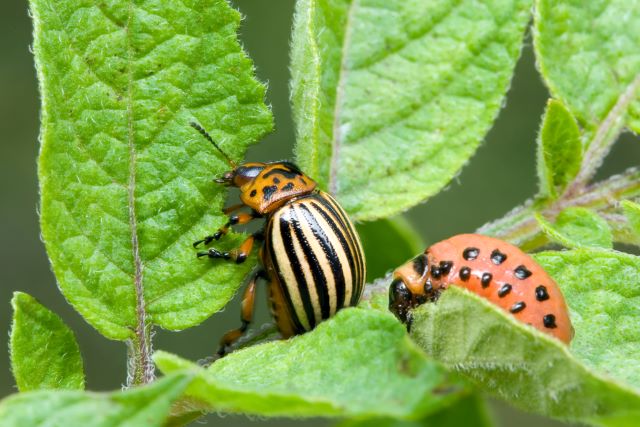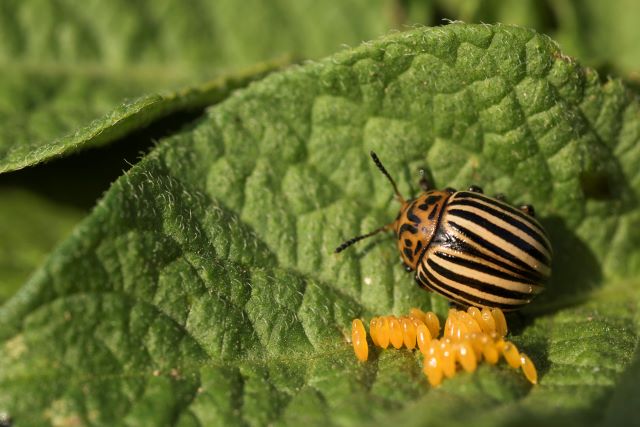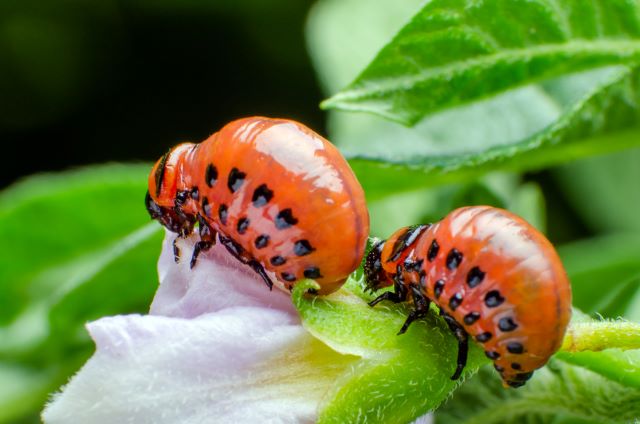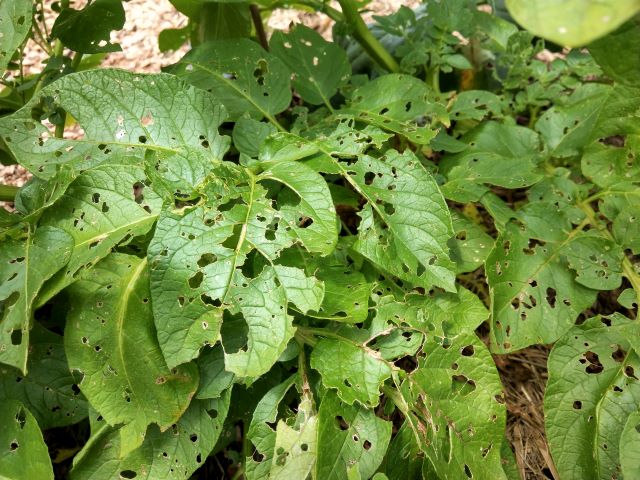If you go out to your vegetable garden to find small, jagged holes in your potato plant leaves, you may be witnessing damage by voracious potato bugs. These beetles, and in particular the potato bug larvae can really chew through your potato leaves and create a mess of your plants. In this article, I’ll cover identifying potato bugs along with evidence of potato bugs and their larvae in your garden and how to get rid of them using natural and organic gardening methods.

To control potato bugs in the organic garden, use organic insecticides, manually remove the larvae and bugs yourself, and create beneficial relationships between your plants by companion planting.
By controlling potato bug populations in your garden, you can prevent chewed-up potato leaves that can eventually be fatal to the potato plant. So let’s find out more about this pest and how to control and eliminate potato bugs from your garden.
Related: How To Grow Potatoes in a Bag
Table of Contents
Firstly, What Are Potato Bugs?

Potato bugs are officially called Colorado Potato Beetles (Leptinotarsa decemlineata). They are small, oval-shaped beetles that look somewhat like ladybugs. You can tell them apart by the potato bug’s yellow coloration and vertical stripes down its back. They also feature black spots on their head.
Measuring around 1/3 inch long as adult beetles, potato bug larvae are also a big problem for potato leaves, actually even more so. The larvae are reddish with black appendages. As they grow, they change color to a reddish-orange with black spots in two rows along the side of their body.
If potato bugs lay and hatch their larvae, they can quickly become a devastating problem for your potato plants as well as a number of other edibles in the nightshade family like peppers, eggplant, and tomatoes.
Potato bug larvae have a huge appetite. So it’s important to control potato bugs so they don’t wipe out your crops.
Potato Bug Life Cycle
These Colorado Potato Beetles can and do overwinter in your garden, hiding in garden debris or the soil.
They emerge again in time for spring when the female potato bug begins laying her eggs on the underside of the potato plant leaves. She can lay up to 500 eggs in a month.
In one to two weeks, the eggs hatch and the larvae start feeding for up to a month.

At this point the larvae drop to the ground, entering the soil to pupate and emerging again around 10 days later as adult beetles.
There are between 1 and 3 generations in one growing season.
Now you know the life cycle of the potato bug, let’s find out how to stop them at each stage of their development.
Natural and Organic Potato Bug Control Methods

If you find your potato crops succumbing to voracious hordes of hungry potato bugs, don’t panic. There are simple, natural, and organic solutions that will leave your potato plants looking healthy and happy again.
If you find potato bugs eating your potato leaves, you might try a combination of these solutions:
- Pick off potato bugs manually
- Plant beneficial plants near your potatoes
- Make an organic pesticide or purchase one
Pick Off Potato Bugs By Hand
The most natural but somewhat time-intensive way to control potato bugs is to pick them off by hand. Wherever you see potato bugs, pick them off with your gloved hand and put them into a container with a mixture of soapy water to ensure that they die.
Their larvae are the easiest to target, and taking out these new generations of bugs is the most important aspect of pest control.
This may seem laborious, but they’re actually quite easy to pick off a potato leaf.
While you’re picking off potato bugs and their larvae, be sure to keep an eye out for any of their eggs on the underside of the leaves. They are also easy to spot as their orange/yellow color contrasts with the green of the leaf.
The easiest way to remove the potato bug eggs is to carefully remove that section of the leaf along with the eggs. Then you can either squish them or pop them in your container of soapy water along with the potato bugs and larvae before disposing of them (I do this in the compost bin once all bugs have died).
Companion Plants to Ward Off Potato Bugs
Many gardeners skip out on this step in the gardening process, turning their garden spaces into monocultures that only grow one plant at a time. But planting a diverse range of plants can actually help each plant survive and thrive when grown together.
Some great plant options to grow alongside your potatoes are marigolds, thyme, mint, cilantro and sage. Not only will herbs help ward away potato bugs, but they’ll also make a delicious addition to your harvest.
Marigolds will also help attract beneficial insects such as ladybirds and lacewings, into your garden that will help feed on the potato bug larvae.

Tansy and catnip are also excellent deterrents to potato bugs.
Green beans also contain compounds that can work to repel potato bugs. Plus, having green beans growing alongside your potatoes means you’ll be harvesting not one but two essential nutrients: carbs and protein.
Make Your Own Organic Pesticide
Some common natural insecticides and repellents can be found in the house or at your nearest department store. These include:
- Soap
- Vinegar
- Essential oils
- Hot pepper powder
While soap is harmless to humans, it’s deadly to insects. Soap strips the protective waxes that help an insect retain water and degrades cell membranes. Essentially, bugs fall apart when they come in contact with soap.
Vinegar is also a pest killer. Its high acidity makes it a deadly addition to any organic pesticide, and it’s safe for humans and pets.
Essential oils don’t kill insects, but their strong scents work as effective repellents for many pests. Good oils to use in an insecticide are thyme oil, peppermint oil, or sage oil.
Finally, try a tablespoon or so of hot pepper powder. Potatoes grow under the ground, so it won’t contaminate your crops with a spicy flavor. Instead, it’ll drive away potato bugs like mad.
If you’re unsure how to make an effective insect repellent using these ingredients, try this recipe:
- 2 cups water
- 1 tablespoon of cayenne powder
- 1 ½ cups vinegar
- 2 teaspoons liquid dish soap (such as Dawn or an organic soap)
Put these ingredients in a spray bottle, mix them all up, and spray them over your potato leaves.
As for the essential oils, I’d recommend placing a few teaspoons into a separate spray bottle and mixing it with water. If you mix it with your other insecticides, the smell, which is what drives insects away, might be diluted by the other ingredients.
Other Organic Control Methods For Potato Bugs
Practice Crop Rotation
As the adult potato bugs overwinter in your garden, planting new potato crops someplace else in the garden the following season, will stop them from finding your plants right away.
Row Covers
It’s a good idea to protect young potato plants with row covers.
Mulch
Mulching around your potato plants will not only help protect them from drying out, but it will also help attract beneficial insects who will in turn feed on pests.
Beneficial Nematodes
Using beneficial nematodes like these will work by eliminating the potato bug during the pupate stage under the soil.
Neem Oil For Potato Bugs
Horticultural neem oil is one of my favorite products to use in the organic garden. And while neem oil does not kill the adult potato bugs, what it does do is stop them from laying their eggs on the potato plant leaves breaking the life cycle of the pest.
Diatomaceous Earth
Spreading Diatomaceous Earth around the base of your potato plants can effectively get rid of pests attacking your potato plant. Try to keep the area dry if possible and results can be seen within a day and up to 5 days from application.
There are other organic pesticides on the market but I prefer to garden as naturally as possible. A combination of these methods will result in getting rid of potato bugs while maintaining a healthy garden that I want to eat from.
So get out there, pick some potato bugs off your potato leaves, spray down those plants, and find beneficial companion plants for your potatoes and you will have a thriving crop of starchy goodness.
If you find your potato leaves are still being eaten and potato bugs are not the cause, you might like to read our article 7 Pests That Eat Potato Leaves And How To Get Rid Of Them.
Further Reading:
